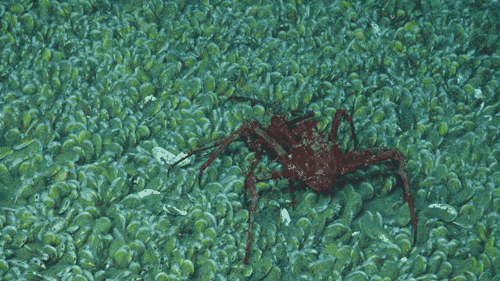Scientists Discover New Marine Life in Atlantic Canyons

A team of federal and university scientists exploring the Norfolk Canyon on a month-long expedition discovered an expansive, "bustling field of chemosynthetic mussels" and the presence of gas seeps in the canyon about one mile below the ocean surface. Chemosynthetic animals have internal microorganisms that ingest and convert molecules such as methane or hydrogen sulfide to produce energy and biomass.
On May 8, maneuvering the Jason remote operating vehicle (ROV) around the canyon, they "came across densely packed mussels that carpeted the bottom as far as the Jason cameras could see." The patches were packed with live mussels, plus a variety of fishes and invertebrates. The methane seep site that the mussels use for nutrition is one of the few currently known off the U.S. Atlantic coast.
|
A lithodid crab seen on the mussel bed at 1,600 meters. Image courtesy of Deepwater Canyons 2013 - Pathways to the Abyss, NOAA-OER/BOEM/USGS |
The discovery took place as part of the Deepwater Atlantic Canyons study funded by the Bureau of Ocean Energy Management (BOEM), the National Oceanic and Atmospheric Administration (NOAA) and the U.S. Geological Survey (USGS). Led by Principal Investigators Dr. Steven Ross (University of North Carolina at Wilmington) and Dr. Sandra Brooke (Florida State University), the researchers were ecstatic when cameras mounted on the Jason zoomed in on this exciting find. The science team includes researchers from seven universities, three federal agencies, and several private sector and oceanographic organizations working aboard the NOAA ship Ronald H. Brown. This expedition builds on discoveries made last year by explorers on NOAA Ship Okeanos Explorer.
This study will expand BOEM's knowledge of the distribution and sensitivity of unique biological habitats in deep water, as well as potential archaeological sites that may warrant protection. While BOEM has no oil and gas lease sales scheduled in the Atlantic for the 2012-2017 program, the research will provide updated environmental and ecological information to inform future decisions and mitigation measures.
To watch the daily blogs from federal and university scientists onboard the 2013 mission, access materials for educators, and ask an explorer questions, visit this link to the NOAA Ocean Explorer page or the mission blog.

